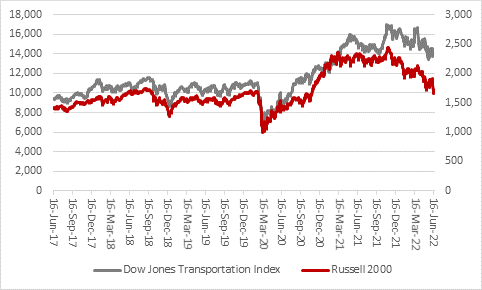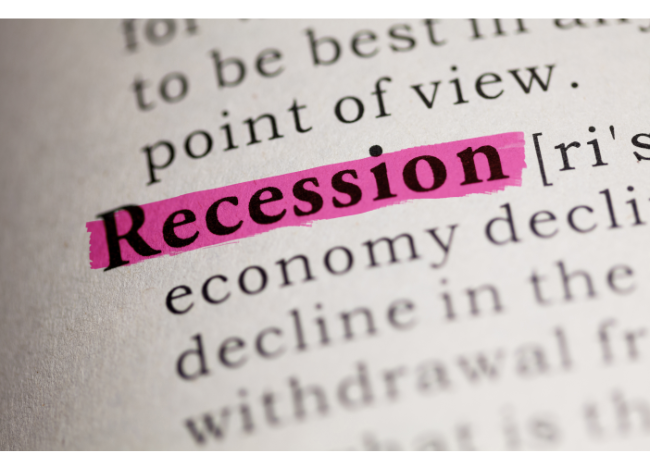In his work Dow Theory, Robert Rhea argued stock market downturns had a distinct shape, when he wrote: ‘There are three classic phases of a bear market: the first represents the abandonment of hope upon which stocks were purchased at inflated prices; the second reflects selling due to decreased business and earnings, and the third is caused by distress selling of sound securities, regardless of their value, by those who must find a cash market for at least a portion of their assets.
The pasting handed out to cryptocurrencies, SPAC deals, meme stocks, momentum plays and new floats over the past year or so could suggest we are well into phase one.
The question now is to what degree markets are pricing in a slowdown or downturn in corporate earnings and, if so, whether they are correct to do so.
The US markets are clearly perturbed – and where America goes the world tends to follow, since it is home to the globe’s largest stock market, largest bond market and the world’s reserve currency.
The Dow Jones Industrials is down 19% from its highs and the S&P 500 by 23%. That suggests some bad news is priced in.
But other indices are clearly frightened that worse news is to come. The Dow Jones Transportation index is down by a quarter from its autumn 2021 zenith, leave it flirting with a bear market, while the small-cap Russell 2000 has already been gored, as it has fallen by a third from its peak.

‘Something had to give’
Profit warnings have started to gather pace, even from stocks that previously looked invincible, such as Netflix, Amazon and even Microsoft. Microsoft blamed the strong dollar, and analysts have tried to brush that one off, but the canary in the coal mine may just have been the retailer Target.
Target dished out two warnings in the space of a month and the key reason was how Target’s inventories of goods on its shelves and in its warehouses had outpaced growth in sales for four straight quarters.
Something had to give – either revenue growth picked up or Target had to stop buying and start discounting.
Target has now admitted that it has started cutting prices and swallowing fines and penalties that result from cancelling orders on its suppliers.
This combination means management now expects the operating margin to slide to 2% in the second quarter, compared to 5.3% in the first and 9.8% a year ago.
That is clearly bad news for Target, but it will hardly bring cheer to the firms that manufacture and supply its products or those that ship them.
The retailer is reportedly the second largest importer of containers into the US so it is no wonder the Dow Jones Transportation index is looking so sick – data from the giant Port of Long Beach in Los Angeles is showing flat volumes for loaded inbound containers for 2022 to date and a year-on-year decline for May.
Worse, Target is not on its own when it comes to piling up inventory.
Federal Reserve data shows that aggregate inventory for US retailers is growing at its fastest rate since records began in the early 1990s.
Private consumption generates about 70% of US GDP so a slowdown here, either a temporary one as retailers whittle down their stocks or a longer one of consumers slow down their spending, could be a major blow to the US economy and the earnings power of corporate America.
The wider danger for US equites
Based on earnings estimates collated by Standard & Poor’s, US equities trade on around 18 times forward earnings for 2022 and 16 times for 2023. Neither of those ratings are particularly out of kilter for historic norms.
However, they do assume that American corporate earnings keep growing and set new peaks in both 2022 and 2023.
That could be a false premise if Target is any guide, especially as work from Standard & Poor’s suggests aggregate consensus estimates for the US stock market are starting to fall.
![S&P 500 Earnings per share - 2000 to 2023[E]](https://s39380.pcdn.co/wp-content/uploads/2022/06/21062022_recession_priced_in_rp_2.png)
In the past month, consensus forecasts for earnings per share have dribbled down by 5% for each of 2022 and 2023, to $217 and $244 respectively.
This perhaps should not be a surprise, given that companies’ input costs, borrowing costs and, in some cases, tax rates are going up.
But the combination of above-earnings multiples and falling earnings forecasts could quickly turn toxic, especially as the S&P 500’s operating margins are already at record highs and analysts are implicitly forecasting further improvement, despite inflation and the threat posed by bulging inventories.
If companies do find themselves with too much inventory, or at least too much of the wrong type relative to customer needs, the ripple effects could be considerable, as transport firms and manufacturers will begin to see a slowdown in demand, too, at least until stocks of goods are down to more comfortable levels.
But it is that slowdown in demand which would see the economy cool, although if there is a silver lining it could help cool inflation too and help to unscramble frazzled supply chains.
Russ Mould is investment director at AJ Bell.

